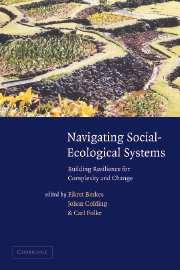Book contents
- Frontmatter
- Contents
- List of contributors
- Preface
- Acknowledgements
- Foreword: The backloop to sustainability
- 1 Introduction
- Part I Perspectives on resilience
- 2 Adaptive dancing: interactions between social resilience and ecological crises
- 3 Nature and society through the lens of resilience: toward a human-in-ecosystem perspective
- 4 Redundancy and diversity: do they influence optimal management?
- Part II Building resilience in local management systems
- Part III Social-ecological learning and adaptation
- Part IV Cross-scale institutional response to change
- Index
- References
3 - Nature and society through the lens of resilience: toward a human-in-ecosystem perspective
Published online by Cambridge University Press: 13 August 2009
- Frontmatter
- Contents
- List of contributors
- Preface
- Acknowledgements
- Foreword: The backloop to sustainability
- 1 Introduction
- Part I Perspectives on resilience
- 2 Adaptive dancing: interactions between social resilience and ecological crises
- 3 Nature and society through the lens of resilience: toward a human-in-ecosystem perspective
- 4 Redundancy and diversity: do they influence optimal management?
- Part II Building resilience in local management systems
- Part III Social-ecological learning and adaptation
- Part IV Cross-scale institutional response to change
- Index
- References
Summary
Introduction
There is a long history in several disciplines of trying to understand the relationship between ecological and social systems. The issue is often glossed as the nature/culture and environment/society dichotomies. Glacken (1967) has provided an extensive and wide-ranging survey of the ways in which the relationship between nature and society have been conceptualized within Western thought up to the eighteenth century. With the Age of Enlightenment, humans were extracted from the environment. The separation of nature and society became a foundational principle of Western thought and provided the organizational structure for academic departments. Since that time, Western thought has oscillated between positions in which nature and society were treated as distinct entities, and one in which articulations between the two were examined.
One of the early attempts to provide a model of natural system–society articulation was the one constructed by Karl Marx in the nineteenth century (Ingold, 1980; Wolf, 1982; Harvey, 1996). The discussion of the relationship between nature and society continued during the twentieth century in many different disciplines. There has been the human ecology of Park (1936), the cultural ecology of Julian Steward (1955), the ecological anthropology of Gregory Bateson (1973, 1979), Netting (1974, 1986, 1993), Vayda and McCay (1975), the ideas of Carl Sauer (1956) and other human geographers, the environmental history of William Cronon (1983, 1995) and Donald Worster (1977, 1988), the ethnoecology of Conklin (1957) and others (Toledo, 1992; Nazarea, 1999) and the emerging political ecology of Greenberg and Park (1994), Peet and Watts (1996) and others.
- Type
- Chapter
- Information
- Navigating Social-Ecological SystemsBuilding Resilience for Complexity and Change, pp. 53 - 82Publisher: Cambridge University PressPrint publication year: 2002
References
- 9
- Cited by



